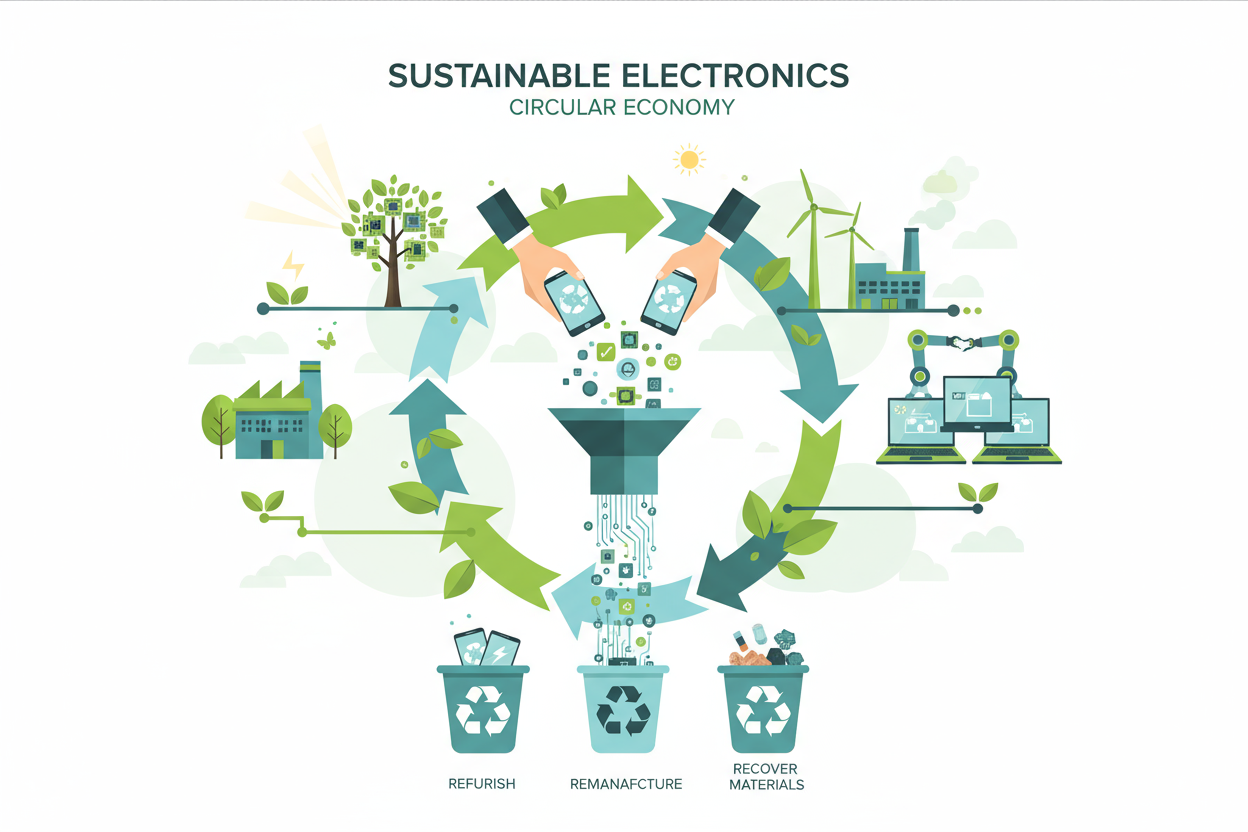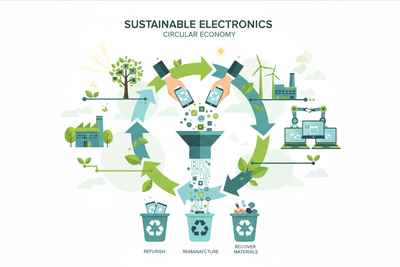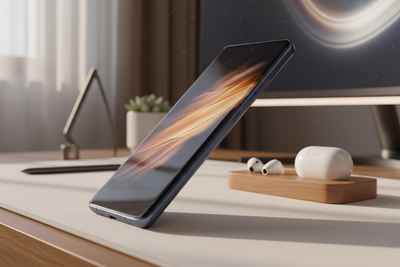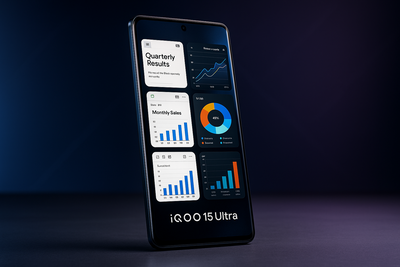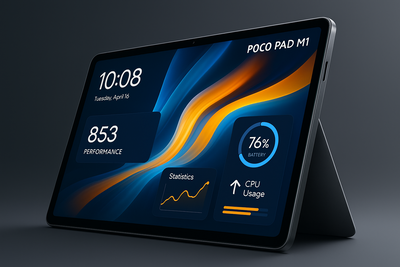Introduction
In the modern technology-dependent era, sustainable materials management (SMM) is an important solution to minimizing mobiles' and laptops' environmental impacts. With millions of electronic devices manufactured, consumed, and disposed of annually, increased responsible treatment of non-hazardous waste is more vital than ever before. The fundamental concept of sustainable materials management is to maximize resource efficiency, reduce waste, and promote recycling and reuse of electronic materials. With the constant development of technology, implementing sustainable waste management measures secures protection of the environment while fostering economic sustainability in the electronics industry.
Understanding Sustainable Materials Management
Sustainable materials management (SMM) is defined as the effective use and recycling of material throughout its entire life cycle — from manufacturing to disposal. For mobiles and laptops, this strategy emphasizes the designing, manufacturing, using, and discarding of products in a responsible manner. Rather than just dumping devices when they are no longer current, SMM encourages recycling, refurbishment, and reuse of valuable materials like metals, plastics, and glass.
By implementing sustainable material management concepts, manufacturers can decrease raw material dependency, save energy, and decrease greenhouse gas emissions. It assists in forming a circular economy where non-hazardous waste is reduced to a minimum and valuable content is reused in the production process. The ultimate objective of SMM is to maximize the life span of resources, reduce waste production, and safeguard ecosystems.
The Problem of E-Waste in Modern Electronics
Millions of laptops and mobiles are discarded every year across the world, adding to the increasing problem of E-waste. Though some of the waste has dangerous material like mercury or lead, most of it is non-hazardous, comprising plastics, copper, aluminum, and silicon. Though recyclable, much of the non-hazardous waste still finds its way into landfills because of inadequate segregation of waste and insufficient recycling facilities.
Sustainable materials management tries to solve this problem by encouraging recycling and reuse of electronics. For example, components such as motherboards, monitors, batteries, and metal chassis can be processed and utilized in the production of new products. This minimizes raw material extraction and reduces damage to the environment. Additionally, safe handling of E-waste avoids wastage of resources and supports maintenance of ecological balance.
SMM in Mobile Manufacturing
Current phone makers are embracing sustainable material management to green their production. Brands such as Apple, Samsung, and Fairphone have launched programs that involve recycled aluminum, biodegradable packaging, and modular construction that facilitates repairs. By using SMM, these producers are shifting the sustainability standard in manufacturing.
One of the major features of SMM in mobiles is design for disassembly. This refers to products being designed so that they are easy to disassemble and recycle. Non-hazardous materials and renewable resources being used, mobile manufacturers can restrict the overall waste footprint. The use of recycled metal and reclaimed plastics further decreases the reliance on mining, which is resource-intensive and damaging to the environment.
Sustainable materials management in the Production of Laptops
Laptop companies are also adopting sustainable materials management to reduce their carbon footprint and promote responsible consumption. Companies such as Dell, HP, and Lenovo are at the forefront of green innovations like recycled ocean plastics, low-energy materials, and closed-loop recycling systems. With these efforts, firms minimize waste without compromising product performance and quality.
The principle of responsible non-hazardous waste management in laptops is based on material recovery. Components such as aluminum chassis, copper wiring, and glass screens are reusable or can be smelted for new products. Firms are also introducing trade-in programs and refurbishment initiatives to extend the life of used laptops. These actions reduce waste while making environmentally friendly technology affordable to more consumers.
Benefits of Sustainable Materials Management
-
Environmental Protection:
By promoting recycling and reuse, SMM minimizes landfill waste and prevents pollution caused by improper disposal of non-hazardous materials. -
Resource Conservation:
Through sustainable materials management, valuable materials like copper, aluminum, and plastic are recovered and reused, conserving natural resources. -
Energy Efficiency:
Recycling existing materials consumes less energy than extracting and processing raw resources, making SMM an energy-efficient choice. -
Economic Opportunities:
The recycling and refurbishment industries create job opportunities and drive innovation in green technology and sustainable waste management. -
Corporate Responsibility:
Adopting SMM enhances a brand’s image, showcasing commitment to environmental and social responsibility, which modern consumers appreciate.
Consumer Role in Responsible Waste Management
While producers have a major role to play, consumers also have an important role in encouraging materials management that is sustainable. Small steps such as recycling outdated devices, buying refurbished electronics, or engaging in trade-in programmers can go a long way. Consumers also need to choose producers who adopt environmentally friendly manufacturing processes and provide take-back programmers.
In addition to this, disposal of non-hazardous E-waste properly makes materials such as plastics and metals reclaimed rather than being dumped in landfills. Awareness about sustainable consumption and E-waste recycling can make consumers responsible, which supports the environment.
Future of Sustainable Materials Management in Electronics
The potential for mobile and laptop sustainable materials management is bright, with innovations in green technology, modular construction, and artificial intelligence-based recycling technologies. With increasing innovation, so will there be increased potential to have a zero-waste electronics sector. The manufacturers are likely to create products that are simpler to recycle, repair, and upgrade — making them live longer and limiting non-toxic waste.
Moreover, refurbished devices are gaining popularity, offering a sustainable and cost-effective option to consumers. This trend is totally in alignment with the objectives of SMM, building a balanced system in which technology and sustainability go hand-in-hand.
Conclusion
Sustainable materials management is the foundation for environmentally friendly handling of wastes in the laptop and mobile sectors. Through recycling, reusing, and minimizing non-hazardous wastes, sustainable materials management promotes nature conservation and efficiency of resources. Be it manufacturers or customers, all parties have a contribution to make towards making sustainability a reality. With each new technology development, incorporating SMM practices into daily operations will not only safeguard the earth but also create a world where digital innovation goes hand in hand with environmental stewardship.
FAQs
Q.1. What is Sustainable Materials Management (SMM)?
SMM is a model that encourages effective use, recycling and reuse of materials to reduce waste and environmental effects.
Q.2. How does SMM help mobile and laptop production?
It minimizes waste, saves resources, and promotes environmentally friendly production with recyclable and non-hazardous materials.
Q.3. What are some examples of non-hazardous electronic waste?
Examples are plastics, aluminum, copper, and glass from mobiles and laptops.
Q.4. In what way can consumers help SMM?
Consumers can recycle used devices, purchase used electronics, and opt for sustainable brands.
Q.5. Why is SMM beneficial to the environment?
It avoids landfill pollution, conserves energy, and encourages a circular economy that preserves material reuse.






